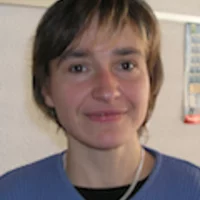Duration: 1 day
Sodiumnitroprusside (Na2(Fe{(CN)5NO]} 2H2O, SNP) is a material which is changing its structural properties when illuminated with light at low temperature. This has been demonstrated by neutron diffraction investigations. Neutron diffraction is interesting as N and O have different scattering lengths for neutrons. This is especially interesting as the electron configuration is not changed significantly, making X-ray diffraction much less sensitive.
We measure in this practicum the ground state structure of the molecule using the single crystal neutron diffractometer ZEBRA. You will learn to perform a single crystal diffraction instrument and to analyse the data.
You will align the SNP crystal, determine the so called UB-matrix as desribed below and measure an overnight data-set at room temperature. During the measurment,you have the possibility to analyse an old data-set measured at 90K, using JANA2006, an advanced program package shown in the supplementary section.
Background information on the scientific case is presented in a paper of Prof. D. Schaniel, describing the structural change (NO-inversion) between the metastable state (called MS1) and the ground state (called GS, and what we are investigating in this internship).
Supplementary Material
Description of the internship:
- zebra-internship.pdf: ZEBRA Internship: Structure Determination of the Ground State of Sodiumnitroprusside using Single Crystal Neutron Diffraction
Supplemetary information:
- Diffraction.pdf: Presentation on neutron diffraction
- The basics of neutron diffraction are outlined in the attached presentation by J. Schefer. It also describes the basic formulism used by data evaluation programs such as JANA2006, the program we will use.
- 1967-Busing-Levy-3-4-circle-Acta22.pdf: Geometrical relation between crystal-system (a,b,c,alpha,beta,gamma) and instrument system (2theta,omega,chi and phi)
- Busing-Levy describes, how the crystal system (a,b,c, alpha, beta, gamma) and the instrument coordinates are related by the so-called 3x3 UB-Matrix. U gives the transforation from a general cyrstal system, a,b,c,alpha,beta,gamma (can be e.g. monoclinic) to an orthorhomic systems, whereas B describes the transfer to the instrument system x,y,z (where you measure). Busing-Levy is the most common convention and is also used by ZEBRA.
- jana.pdf: Manual of the computer program JANA2006 for analysing single crystal diffraction data
- Jana2006 is a commonly used program to analyse single crystal data. It handles all the formulism described in the diffraction books. You will get a hardcopy of the manual (written as a cookbook) at the instrument. You can download it at http://jana.fzu.cz/. Installation on a PC is sraight forward, on a MAC you may need advice (please register free of charge, if you are installing it to allow the authors continuing upgrading this program).
- 2006-Schaniel-MS1-Structure-PRB-73-174108.pdf: Scientifc Case (Prof. D. Schaniel)
- This paper describes the background why we are investigating this strucuture and why neutron single crystal diffraction has been used. It also gives you access to the literature related to this subject.
Contact information:
Laboratory for Neutron Scattering and Imaging (LNS),
Paul Scherrer Institut, CH-5232 Villigen PSI
+41 56 310 20 87 (Pamela Knupp, Secretary)
Last revision : April 20, 2013 by O. Zaharko, mailto:oksana.zaharko@psi.ch
